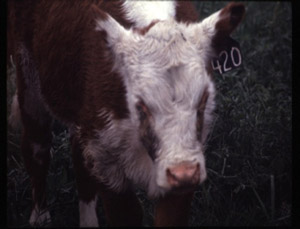Pinkeye in Cattle
February 2014
 Pinkeye is a highly contagious infectious disease that affects cattle worldwide. The incidence and severity of this common disease can vary widely from year to year. Although pinkeye rarely causes the death of affected cattle; it can cause substantial losses to the cattle industry through decreased weight gain, lowered milk production and treatment costs.
Pinkeye is a highly contagious infectious disease that affects cattle worldwide. The incidence and severity of this common disease can vary widely from year to year. Although pinkeye rarely causes the death of affected cattle; it can cause substantial losses to the cattle industry through decreased weight gain, lowered milk production and treatment costs.
A recent video "Prevention and Care for Pinkeye" discusses the disease along with management practices to prevent and treat it.
Description and Causes
Pinkeye is known to occur at all seasons of the year and in all breeds of cattle. Excessive weeping of the affected eye and closure due to pain are the two signs most commonly observed. As the disease progresses, the cornea becomes cloudy or white. An ulcer frequently develops near the center of the cornea. Cattle with pinkeye keep the affected eye or eyes closed because of pain and to avoid bright sunlight. The course of the infection may run for several weeks.
Pinkeye is primarily caused by Moraxella bovis (M. bovis); however, other organisms have been isolated from eyes with infections resembling pinkeye. It remains unclear whether these other organisms are primary pathogens or opportunistic, secondary invaders. Pinkeye is caused by a combination of factors. Other factors instrumental in causing eye irritation, thereby allowing for invasion of M. bovis and subsequent disease, are excessive ultraviolet light (sunlight), biological vectors (face flies, house flies, stable flies), plant material and dust.
Control Program
A good control program should incorporate procedures to reduce initial eye irritation.
- An intensive fly control program is essential to limit the spread of pinkeye in a herd of cattle.
- Reducing dusty conditions and providing protection against sunlight also aids in control. Cattle often have grass or weed seeds in their eyes, and these materials no doubt irritate the eye and contribute to the development of pinkeye.
- Vaccinations for pinkeye have met with variable results. Typically vaccinations help reduce the incidence, shorten the duration and reduce the severity of cases but cannot guarantee total prevention of an outbreak.
Consult with Your Veterinarian
There are other infections that look like pinkeye so it is recommended that you consult with your veterinarian to assist you in the diagnosis, treatment and control of pinkeye.
Dr. Richard Randle
UNL Extension Beef Veterinarian
University of Nebraska